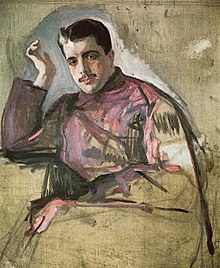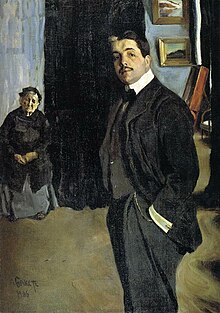Sergei Pavlovich Djagilew

Sergei Diaghilev ( Russian Сергей Павлович Дягилев ;. Scientific transliteration Sergej Pavlovič Djagilev ;. French transcription Serge Diaghilev ; born March 19, jul. / 31 March 1872 greg. In Selischtschi , Russian Empire , in Perevoskij Rajon in Nizhny Novgorod ; † August 19, 1929 in Venice ) was a Russian editor , art critic , curator and impresario .
The staunch Saint Petersburg native made a significant contribution to making Russian art of the turn of the century, especially ballet , known in western countries as well. His performance practice of the Ballets Russes , which he founded, established, together with the avant-garde of music, choreography and scenic art, a choreographically and scenic form that was completely new in the work of Igor Stravinsky , Michel Fokine , Vaslav Nijinsky , Ninette de Valois and George Balanchine founded neoclassicism in ballet and shaped the art of ballet in the 20th century.
Life
The early years
Djagilev moved to Saint Petersburg in 1890. Originally he wanted to study law there, but soon felt much more drawn to the flourishing art, music and theater life in the city. He tried his hand at music, painting and ballet, but quickly noticed that his own talent did not meet his requirements.
It was only on a trip to Europe in the mid-1890s that he discovered his real talent. He began collecting paintings, old furniture and bronze objects, he visited theaters and museums, met Émile Zola , Jules Massenet , Charles François Gounod and Arnold Böcklin . It turned out that he had a great ability to bring artists and art together. He devoted his entire life to promoting art .
While still in Saint Petersburg, he founded the progressive art magazine Mir Iskusstwa ( The World of Art 1899-1904), with which he developed the art life of , among others with the painters Alexander Benois (Alexander Nikolajewitsch Benua), Léon Bakst (Lew Samoilowitsch Bakst) and Konstantin Somow Strongly influenced the city. In 1899 he became artistic advisor to the imperial theater in Moscow and staged numerous operas and ballets there.
From 1904 to 1908 he showed Russian and other art abroad. He began with an icon exhibition in Paris, then gave concerts in the Grand Opéra with works by Mikhail Glinka , Alexander Borodin , Modest Mussorgsky , Nikolai Rimski-Korsakow , Pyotr Ilyich Tchaikovsky and Alexander Scriabin . Djagilev always refused to repeat proven concepts and relied on new, spectacular, often perceived as scandalous. In 1906 Paris became the center of his life.
Ballets Russes
Dyagilev's greatest lasting achievement was in the field of ballet . In 1909 he put together the Ballets Russes ensemble from the best dancers in the country . This toured large parts of the world and made the Russian ballet known. After the October Revolution , Dyagilev and the ensemble stayed abroad.
Because of his spectacular performances, which were not always financial successes, but also because of his passion for collecting, in later years for Russian books, Pushkin letters and autographs, among other things , his financial circumstances were always precarious. The generous support of Gabrielle Coco Chanel for individual projects was also of little help.
In 1910 he organized the first of 20 ballet seasons in Paris. This period was of enormous value in the development of ballet as a performing art in theater. He promoted the Russian ballet with famous dancers such as Anna Pawlowa and Vaslav Nijinsky , with whom he was in a relationship for several years.
Djagilew used music by well-known composers such as Claude Debussy ( Jeux , 1913), Maurice Ravel ( Daphnis and Chloé , 1912), Erik Satie ( Parade , 1917), Richard Strauss ( Josephs-Legende , 1914), Ottorino Respighi ( La Boutique fantasque , 1918), Francis Poulenc ( Les Biches , 1923). His choreographer Michel Fokine mostly adapted the music for the ballet.
The artistic director for the Russian Ballet was Léon Bakst , with whom Dyagilev and Alexander Benua founded the art magazine Mir Iskusstwa . Together they developed a more difficult form of ballet with elements that were intended to please the general public, not just the aristocracy . The exotic appeal of the Russian ballet had an impact on the emerging Art Deco .
However, the most notable composer Dyagilev worked with was Igor Stravinsky , and so the premiere of The Firebird on June 25, 1910 brought them international recognition. Petruschka (1911) and Le sacre du printemps (1913) followed shortly afterwards, and later Pulcinella (1920) and Les Noces (1923).
In addition to Léon Bakst and Alexander Benois , Henri Matisse , Georges Braque , Maurice Utrillo , Jean Cocteau , Nicholas Roerich and Pablo Picasso also worked for him as stage designers . He also engaged eminent choreographers: George Balanchine , Léonide Massine , Bronislava Nijinska and Serge Lifar .
In the 1920s Dyagilev lived with the much younger Boris Kochno , who was also his secretary and librettist. Djagilew died in exile in Venice on August 19, 1929 in the Grand Hotel des Bains and was buried there in the orthodox part of the cemetery island of San Michele . He had Venice, the constant stimulator of our appeasements, engraved on his tombstone . In the USA, France and Italy there are now plaques with his name; A square is named after him near the Opéra Garnier in Paris , and the “greatest impresario” has a monument in Monte Carlo .
literature
- Richard Buckle: Diaghilev. Weidenfeld and Nicolson, London 1979, ISBN 0-297-77506-5 .
- Serge Lifar : Serge Diaghilev. His life, his work, his legend. An Intimate Biography. GP Putnam's Sons, New York NY 1940.
- Jane Pritchard (Ed.): Diaghilev and the Golden Age of the Ballets Russes. 1909-1929. V&A Publishing, London 2010, ISBN 978-1-85177-613-9 (catalog for the exhibition of the same name at the Victoria and Albert Museum , London, September 25, 2010 - January 9, 2011).
Web links
- Literature by and about Sergei Pawlowitsch Djagilew in the catalog of the German National Library
- Works by and about Sergei Pawlowitsch Djagilew in the German Digital Library
Individual evidence
- ↑ Alastair MacAulay: Protean Master of the Ballets Russes . In; The New York Times, August 25, 2010
| personal data | |
|---|---|
| SURNAME | Djagilew, Sergei Pavlovich |
| ALTERNATIVE NAMES | Дягилев, Сергей Павлович (Russian); Diaghilev, Serge (French transcription) |
| BRIEF DESCRIPTION | Russian editor, art critic and curator |
| DATE OF BIRTH | March 31, 1872 |
| PLACE OF BIRTH | Selishchi , Russian Empire |
| DATE OF DEATH | August 19, 1929 |
| Place of death | Venice , Italy |

